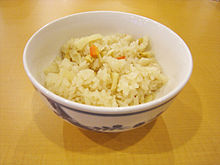
Takikomi gohan (炊き込みご飯, 炊き込み御飯) is a Japanese rice dish seasoned with dashi and soy sauce along with mushrooms, vegetables, meat, or fish. The ingredients of Takikomi gohan are cooked with the rice; in a similar preparation, maze gohan (混ぜ御飯), flavorful ingredients are mixed into the cooked rice.[1] In the kansai region, Takikomi gohan is called Kayaku gohan, and in Okinawa, it is called Jucy.[2] This dish is consumed by people in Japan around the fall season since a lot of root vegetables and mushrooms are harvested during this season in Japan.[3] Ingredients will vary based on the seasonal vegetables and fish. Since this dish covers a lot of nutritional facts, and substitutes a partial amount of rice from a serving size with vegetables and proteins, thus some Japanese people eat it for dieting purposes.[4] One of the reasons why this dish is very popular in Japan is because it is easy to make and does not require a lot of equipment to prepare.
History edit
Takikomi Gohan was created during the Nara period.[5] During this period, Japanese people had a hard time harvesting rice to meet their demands. Thus, they mixed rice with millet to increase the amount of portions. It is called Awameshi. At the same time, people created the root of Takikomi Gohan. It is called Katemeshi. They mixed rice with millets and a variety of vegetables including weeds, yam and Japanese radish in order to survive a shortage of rice. This dish used to be a survival meal during World War II. During the Muromachi period, Katemeshi became popular in Japan, thus Japanese people made a similar dish to Katemeshi. It is called Kawarimeshi. Kawarimeshi uses the same ideas as Katemeshi to create the dish. However, the difference between them is that Kawarimeshi uses quality ingredients such as barley, beans, and vegetables. Over time people became creative and made a variety of dishes that were based on Kawarimeshi, and they used seasonal ingredients to maximize the umami taste in the dish.
Difference from maze gohan edit
The process of making Takikomi Gohan is usually adding all the ingredients such as rice, broth, soy sauce, vegetables and a protein source into a rice maker at once, on the other hand, Maze gohan mixes ingredients such as vegetables and a protein source with cooked rice.[6]
Variations edit
- Tai-meshi (鯛飯): rice with whole sea bream [7]
- Ayu-meshi (鮎飯): rice with whole sweetfish
- Matsutake gohan (松茸御飯): rice with matsutake mushrooms
- Kani-meshi (蟹飯): rice with crab
- Gomoku meshi (五目飯 or gomoku gohan 五目御飯): loosely translated, "five ingredients mixed rice," whose contents often revolve around seasonal availability and can include matsutake or shiitake mushrooms, bamboo shoots, burdock root, fresh soybeans, chestnuts, chicken, firm white-fleshed fish, or oysters.[8] In the Osaka dialect, this dish is called kayaku gohan (加薬御飯).[9]
- kamameshi (釜飯): all the ingredients are cooked in a single use kettle and serve as is[10]
- Kuri gohan(栗ご飯): rice with chestnuts[11]
See also edit
- Arroz con Pollo, Arroz con gandules, Platillo Moros y Cristianos, Gallo Pinto, Pabellón criollo, Rice and beans (Latin America)
- Biryani (South Asia)
- Fried Rice (East Asia)
- Jambalaya (Louisiana)
- Jollof rice (West Africa)
- Hoppin' John (Southern United States)
- Kabsa (Saudi Arabia)
- Kedgeree (United Kingdom)
- Kushari (Egypt)
- Nasi Goreng (Indonesia)
- Paella (Spain)
- Pilaf/Pulao (Greece, Balkans, Turkey, Iran, Central Asia, South Asia)
- Rice and peas (Caribbean)
- Risotto (Italy)
- Spanish rice (Mexico)
Notes edit
- ^ Tsuji, Shizuo. Japanese Cooking: A Simple Art. Kodansha International. 2006, p. 276.
- ^ Aniwotawiki. (2020, October 29). 炊き込みご飯 - アニヲタWiki(仮)【10/29更新】. Retrieved October 30, 2020, from https://w.atwiki.jp/aniwotawiki/pages/4126.html
- ^ 9月に美味しい旬の野菜. (n.d.). Retrieved November 05, 2020, from https://foodslink.jp/syokuzaihyakka/syun/monthly/septembre-ve.htm
- ^ Watanabe, A. (2020, October 05). 炊き込みご飯のカロリー・糖質は?白米よりダイエット向きな理由は?. Retrieved November 05, 2020, from https://chisou-media.jp/posts/598
- ^ K. (n.d.). Okome to gohan no zakugaku. Retrieved October 15, 2020, from http://www.ne.jp/asahi/kiichiro/hp/info_p5.html Published by Shokuryou agency, Zenkoku beikoku kyoukai
- ^ 基本の五目炊き込みご飯のレシピ/作り方:白ごはん.com. (n.d.). Retrieved October 30, 2020, from https://www.sirogohan.com/recipe/kayakugohan/
- ^ Tsuji, Shizuo. Japanese Cooking: A Simple Art. Kodansha International. 2006, p. 277.
- ^ Tsuji, Shizuo. Japanese Cooking: A Simple Art. Kodansha International. 2006, p. 278.
- ^ Tsuji, Shizuo. Japanese Cooking: A Simple Art. Kodansha International. 2006, p. 278.
- ^ Kamameshi, Tororomeshi. (n.d.). Retrieved October 30, 2020, from https://www.asahibeer.co.jp/area/04/shitamachi/vol01.html
- ^ Aniwotawiki. (2020, October 29). 炊き込みご飯 - アニヲタWiki(仮)【10/29更新】. Retrieved October 30, 2020, from https://w.atwiki.jp/aniwotawiki/pages/4126.html
References edit
- Hosking, Richard. A Dictionary of Japanese Food: Ingredients & Culture. Tuttle Publishing, 1997, p. 46
- Tsuji, Shizuo. Japanese Cooking: A Simple Art. Kodansha International. 2006, p. 278.
- Aniwotawiki. 炊き込みご飯 - アニヲタWiki(仮). アニヲタWiki(仮), October 30, 2020
- 9月に美味しい旬の野菜. November 05, 2020
- Watanabe, A. 炊き込みご飯のカロリー・糖質は?白米よりダイエット向きな理由は?. November 05, 2020
- Kiichiro. Okome to gohan no zakugaku. Shokuryou chou Zenkoku beikoku kyoukai. part 5
- 基本の五目炊き込みご飯のレシピ/作り方:白ごはん. October 30, 2020